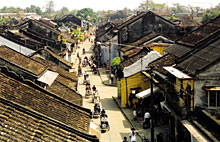Central Quang Nam Province is racing to preserve Hoi An City to ensure the historic city’s tourism potential and aim luring more tourists to the UNESCO-listed site in the future.
 The project, worth about $60 million, will be implemented this year and scheduled to conclude in 2020. Under the plan, the province will seek to restore and preserve the historic residences at the city centre, as well as to limit urbanisation around the preserved areas.
The project, worth about $60 million, will be implemented this year and scheduled to conclude in 2020. Under the plan, the province will seek to restore and preserve the historic residences at the city centre, as well as to limit urbanisation around the preserved areas.
“We are witnessing a rapid downgrading and urbanising process in Hoi An that could make this site less attractive to tourists. Therefore, it is our key task to urgently preserve the cultural features of Hoi An,†said Vo Phung, director of the Hoi An Culture and Sport Centre.
Hoi An was recognised as a World Heritage site by UNESCO in 1999, with buildings that display a unique blend of local and foreign influences. During the 15th to 19th centuries, Hoi An was an important trading port, welcoming Indian traders, all of whom left their stamps on the city’s development. Over the past decade, this well-known site has won the hearts of both foreign and domestic tourists alike. Quang Nam authorities’ estimates put the number of tourists visiting Hoi An City in 2009 at about 1.2 million, and the number of visitors is forecast to reach 2.6 million by 2015.
While investors are flocking to Hoi An to develop high-end resorts in order to meet this increasing demand, Phung admitted that the local tourism industry could be seriously affected due to the deterioration of the city centre and the urbanisation of surrounding areas.
According to the project on preserving Hoi An City, the province will call on local residents and private companies to participate in preservation activities. In the first phase of the project, about 700 ancient houses will be upgraded. The province will also upgrade the wharves at the ancient port, along with preserving and developing the traditional craft villages surrounding the city.
A buffer zone will be created between Hoi An City and surrounding areas in order to mitigate the impact of urbanisation on the city. Improving local infrastructure, especially transport infrastructure, is another important part of the project.